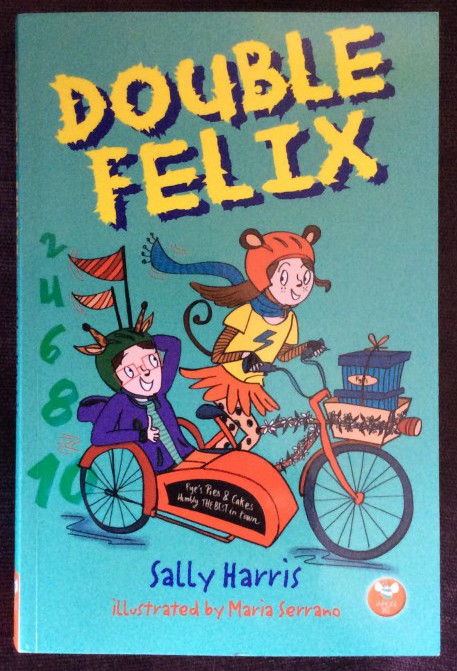Inspiring Young Readers
 posted on 20 May 2018
posted on 20 May 2018
Double Felix by Sally Harris, illustrated by Maria Serrano
I’m pleased to report that Scribbly Gum Primary School seems to be a very relaxed and inclusive sort of place. This is fortunate because eleven year old Felix is a boy who responds best to structure and routines and when these are disrupted he has a mega panic which can cause chaos.
The story opens with him locked inside the head teacher’s office by himself where he’s trying to reorganise and order everything so that it fits with his need for objects to be placed in even numbers. This involves throwing one of the five framed pictures into the bin and he shreds a third cushion to get rid of it. He explains that he had to seek refuge there because a supply teacher in his class insisted on doing science experiments instead of the timetabled spelling lesson. All the other children were very excited about this but he was outraged and succeeded in wrecking the lesson - yet again.
It is obvious that Felix is on the Autistic Spectrum, although this is never stated ( I’m not sure why ), but he is becoming acutely aware about the fact that he is different and has no real friends. His classmates tolerate his often odd behaviour but every new incident when things go wrong make him feel anxious, particularly as he likes going to school. He regularly uses the school library as a sanctuary where he is always welcomed by Miss Claudette, the friendly librarian as he is excellent at replacing all the books in the right places.
Home life is equally fraught - his mum is about to have a fifth child which will be very disruptive for Felix because it means that as the total of family members will add up to seven which is one of those bothersome odd numbers. He is perfectly ok if everyone accepts that he needs order and the freedom to carry out his many rituals which include counting the slats on his brothers bunk bed before he gets up in the morning, having his cereal presented in a particular way, tapping the car door handle twice before he gets out and greeting people he knows twice consecutively. His complicated rituals make him feel safe but he knows that they are also creating barriers. His favourite bolt hole at home is in the cellar where he keeps his collection of toy arks and finds it very soothing to arrange the animals two by two.
As a result of virtually destroying the head teachers office ( without meaning to) his parents and teachers recommend that he goes for a meeting with Hugo, the school counsellor to discuss how he might be able to manage his feelings more effectively. This proves to be an excellent decision as Hugo turns out to be an unconventional but very helpful professional who listens to Felix and tries to help him to take control. He suggests that it is helpful to think about his anxieties as a physical creature living inside his brain who is trying to prevent him from enjoying life. He has to learn how to do battle with this creature and let it know who is boss if he is ever going to be able to relax. I’m not quite sure why Felix appears to have had no support before this but it is a story and it is set in Australia - maybe things are done differently there?
Felix is determined to tackle his problems as suggested by Hugo and makes good progress over several weeks. But the real catalyst in his life is Charlie, the new girl who arrives in the class and sits in the desk seat next to him. Even he realises that she is a little bit odd because she wears a variety of accessories like cats ears and a tail and seems to tune in to his idiosyncrasies very easily. It turns out that she has a brother who is unable to cope with school because of his more profound learning difficulties. They form a friendship which is a big novelty for Felix, although he doesn’t always understand how to make it work.
I liked this book precisely because it presents differences as ‘ normal’ and interesting with two child characters who are clearly cherished by their parents. One of the reviews suggests that it has a similar upbeat tone to the recent much acclaimed TV drama series ‘A is for Autism’ which shows a family placing the autistic child at the centre and going along with all his ritualistic behaviours without question, even though these can be more difficult to accommodate as he gets older. I think that the difference is that this book is aimed at children and so focuses on all the positives. My one reservation is that Felix is able to modify his behaviour relatively easily once he decides that he wants to, and that is not always the case with children on the Autistic Spectrum.
But as with all stories that include children with a disability, it needs to have a good plot and well developed characters to make it a winner with children. This one certainly succeeds in doing this and the lively illustrations contribute to making it one that would be enjoyed by anyone who loves a good school story with a twist.
Karen Argent
May 2018